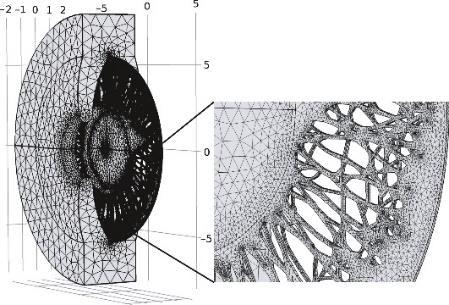
29 minute read
DATABASE OF ABSTRACTED DESIGN PRINCIPLES
ACTA FACULTATIS XYLOLOGIAE ZVOLEN, 64(2): 97−108, 2022 Zvolen, Technical University in Zvolen DOI: 10.17423/afx.2022.64.2.10
97
Advertisement
Zuzana Tončíková – Katarína Csúzová
ABSTRACT
The paper is focused on the methods for the emulation of biomimetic properties of wood by creating a database of abstracted design principles into a form understandable for designers. The database was created according to the proposed procedure. It can serve as a tool for introducing the nature as a model, a mentor, a pattern, and as a measure for the development of innovative sustainable solutions in different areas of design. Designers will be able to use the database in a visually understandable and graphically elaborated form of insights into nature and instructions on how to use its perfectly functional creations, like reference models of what works and what can be applicable to their solutions. Key words: bioinspiration, wood, design, biomimetics, biomimicry.
INTRODUCTION
The research is focused on the use of the biomimetic properties of wood (in living and non-living form) and extend the applications of visual, physical, mechanical, biological, and functional parameters to a new form of design. The principles for functional and aesthetic properties of products created by this method will be abstracted from anatomic elements, morphology, the microscopic and submicroscopic structure of wood, and other wood elements.
The new perception of utilization concerning biomimetic properties of wood stimulates a new scientific investigation of ways how to apply them in practice from the perspective of experts from art and design, wood science, phytology, biology, and woodprocessing technologies. Efforts were undertaken to use the underlying principles for the design of new optimized synthetic materials and/or structures or to use natural materials as prototypes and models themselves (STANZL-TSCHEGG 2011). One of the special features of wood, which contribute to its manifold optimized properties, is its hierarchical architecture (FRATZL and WEINKAMER 2007). The basic structural units of this architecture are elongated cells, which form layers, which finally result in a complex anisotropic construction. Wood is the prototype of the “matter” but does not have the attributes of passivity that one usually confers to materials. The plant is adaptive to the environment and synthesizes cell wall structures that confer activity to wood materials even when the corresponding plant cells are not anymore living. This activity subsists when wood materials are collected for technical use (EDER et al. 2021). Wood provides patterns for the development of optimized growth and exceptional functional properties including the ability to move without muscles in specific directions (ELBAUM et al. 2007; DAWSON et al. 1997; BASKIN et al. 2006). In
general, wood is structured hierarchically, and it has different attributes and specific characteristics in many dimensions. In its very essence, it is the entire interaction of characteristics in each scale, whichgives a base to material property. The structural hierarchy of wood in combination with the principles of a biomimetic design, but also the physical and chemical properties of wood including the strategy of the functioning living tree as an organism are the key reasons why materials and subsequent designs inspired in this way would have their interesting abilities and properties (BURGERT and FRATZL 2009). For example, persistence, self-correction, movement, releasing a scent, processing of sonic waves, air humidity, etc. Such products could integrate comprehensively a sensor, a switch, and a regulator, as well. The simulatingof these living and non-living plant systems provides the uncommon conceptual and practical framework for their application into a new form that reacts to their environment (ALAM 2015). The primary tool of a design becomes a parametrical projection. Possibilities and the accuracy provided by 3D printing will influence the development of future ways of design significantly, as well as the art in future decades. In some sense, the printing process is comparable to plant growth processes and living wood has recently been considered additively manufactured by cell division and expansion (THIBAUT 2019). The 4D print structures which perform consecutive motions, inspired by the Bhutan pinecone scales were created (CORREA et al. 2015; CORREA et al. 2020). The different approach was evaluated with 3D wood printing (MARKSTEDT et al. 2019). Inspired by wood being grown into the shape of chairs, which is a slow natural process, they sped up the manufacturing process by 3D printing to fabricate artificial cellular wood-like structures that mimic biogenesis. Our possibilities of applied research in the field of bio-inspired innovations are exponentially growing and designers play a key role in finding ways to implement these discoveries into usable solutions (GOSS 2010). New methods of biomimicry (BENYUS 1997, GULMANELLI 2008) have been successfully applied in many projects related to applied research when scientists conducted applied research related to bio-inspired innovations in one team with artists and designers (BAUMEISTER et al. 2013). These methods proved to be highly effective in speeding up and clarifying the entire process of biological mechanisms transfer from biology to design. The biomimicry practice follows a well-organized but flexible transdisciplinary team-based design process applicable to any kind of tangible or intangible design challenge (ROWLAND 2017). The emulation of natural systems into the design is proving to be highly effective for the emergence of sustainable innovations in the future (TONN 2007). However, analyses show that there is currently only a 12% of similarity between biology and current technologies that are available on the market (VINCENT et al. 2006).
The uniqueness of our research in the field of biomimetics is in focusing on a particular group of data and inspiration sources based on wood, as well as targeting the application in the field of furniture, interior, and housingby using an adaptedbiomimicry approach focused on wood as a source of biological mechanisms, strategies, and sustainable biological Life´s principles to set the bridge from biology to design (Tab. 1). This path is most appropriate when the design process initiates with an inspirational biological insight (including a biological Life’s Principle / strategies / mechanisms). The discovered biological strategies might inform new innovations in ways that generate interest from non-biologists. This will also consider the context of assumed creative activities, the individuality of interpretation, and the artistic expression of involved investigators. As the research focuses on the biomimetic properties of wood – as a form of a living organism as well as a natural material, one of the first innovative outputs will be a database that aims to present nature as a model, mentor, and measure for innovative and sustainable solutions of diverse design aspects in an understandable form for designers.
98
Tab. 1. "Biology to Design is a specific path through Biomimicry Thinking." (“DesignLens: Biomimicry Thinking - Biomimicry 3.8”) Source: Biomimicry.net, adapted from (BAUMEISTER et al. 2013, Rowland 2017).
BIOLOGY TO DESIGN
1. Discover natural models
Find an inspiring organism or ecosystem and learn about its unique strategies for survival.
2. Abstract biological strategies
Determine the mechanism behind the organism’s or ecosystem’s strategy and translate that into a design principle by removing biological terminology.
3. Identify function
Using the strategy and your design principle as a guide, define what functional need is being met. The function should be the same for both.
4. Define context
Brainstorm applications where this function is needed. Who needs to do what your biological example is doing?
5. Brainstorm bio-inspired ideas
Think of ideas for how to combine the context, function, and design principle(s) to solve a challenge.
6. Integrate Life’s Principles
As you consider your ideas, make sure you incorporate Life’s Principles into the solution.
7. Emulate design principles
Focus onthe best ideas from your brainstorm and develop a design concept. Consider aspects of scale, and whether you can go beyond emulating form and emulate process and ecosystem.
8. Measure using Life’s Principles
Assess your design using Life’s Principles as a reference.
EXPERIMENTAL PART
Bioinspiration and its methods such as Biomimetics and Biomimicry represent one of the promising strategies for the change of the current paradigm of creation towards a system approach of hybrid thinking in design. Emulating nature's strategy into a human design requires a deep understanding of biology and literally translating that strategy into a language understandable by designers, engineers, and architects. The ability of this interpretation requires a considerable amount of knowledge from various disciplines, creativity, and a lot of experience. We call this method of "translation" or "interpretation" into a form comprehensible to the designer the abstraction of design principles. Design principles are something like instructions on how to emulate biological mechanisms in our "artificial" human designs. It must be taken as a fact that reading a scientific publication about a certain organism does not always automatically motivate a designer to pick up a sketchbook and come up with the application of a given strategy to breakthrough innovation (BAUMEISTER et al. 2013).Therefore, the derivation or abstraction of design principles from natural models proved to be a practical aid for the designer.
This abstraction is one of the most difficult steps and the most critical part of Biomimetics and Biomimicry. The moment of interpreting the mechanism of how the natural world works so that it is simply understandable to a designer, inventor, artist, or innovator is a process that can only be learned through repeated practice and repetition. This process is largely interdisciplinary. It is necessary to fully understand how nature achieves the given functions.
The abstracted principle of design must be defined in a neutral language that is "unbiologized" and comprehensible to both worlds - biology and design (HELMS et al. 2009).
The design principle should capture the essential essence of the biological mechanism and translate it in a way that is biologically accurate, but devoid of biological "vocabulary", with no obvious connection to nature. For our applied research, it is necessary to create a database of design principles abstracted in this way. The proposed methodology assumes that the greater the number of abstracted design principles available to designers, the greater
99
the chance that one of them will be applied to the design of a radical sustainable innovation within the creative process. For clarity of the creative process, it is convenient to sort the abstracted principles into so-called "function cards". Function cards in the case of our research represent a database of instructions for applying bio-inspired properties derived from wood, which contain a succinctly explained strategy and described mechanism of what we are looking for and derived "un-biologized" design principle. An example of a function card created in this way is shown in Tab. 2. The first step in abstracting is rather technical. At this point, the biological mechanism behind the function must be understood in as much detail as possible. The mechanism describes exactly how the strategy works. And the strategy explains how the function is achieved. Function names what nature does. A mechanism can work at the level of shape, form, processes, or interactions with the environment. The level of precision and detail required to correctly abstract design principles vary depending on the application. The mechanism must also include a simplified infographic that explains how the mechanism works. The essential activities of the first stage will enable the establishment of a database of procedures in a form of function cards as it is described in Tab. 2.
Tab. 2 Function card – Bordered pits of conifers; (part of the database of biomimetic design principles taken from wood).
FUNCTION CARD - Bordered Pits of Conifers
Function 1 capturing and filtration of gases, microbes, solid microparticles 2 closure of the pit under the action of physical laws
Biomimetic function taxonomy
Distribution, moving
Strategy Closure of the pit under the action of physical laws (natural forces - without the use of mechanical) Mechanism The pits consist of openings in the cell walls of two adjacent tracheids, which ensure the water flow in a tangential direction and prevent the transition of air embolisms and microbes through the wood. The mechanism lies in the shape of the pit itself. Between the mentioned holes is a freely movable membrane consisting of a torus and a margo, which resemble a circular trampoline. The impermeable torus serves as a support and the permeable margo represents the supporting springs in the form of a membrane which hold the torus in place. The bottom line, however, is that this construction makes the pits able to move and close. Under normal conditions, the torus is in the centre of the chamber and water flows through the large pores of the margo. An open pit is roughly 100-500 nm in diameter, which is small enough to prevent the transition of unwanted microbes, but large enough to allow water to flow. However, if air enters one of the tracheid, a pressure differential is created between the air-embolized and water-filled trachea, which deflects the torus across the chamber and occludes the porus - hole, preventing air from moving into the water-filled trachea. The torus is then said to be sucked in and sealing the embolized trachea from the adjacent ones. Because tracheids in conifers are relatively short, air does not enter the tree before the pits are closed.
Design principle
A product (object), which we want to be able to close or open without the use of mechanical forces, using only the laws of nature (air pressure, water pressure, heat pressure), must be designed so that the formation resembles a circular trampoline placed in the centre of an open circular chamber, and which would consist of a fixed impermeable circular form on a movable permeable membrane. In the case that a compressive force was applied to such a formation from one side, the inner movable part would line the edge of the hole, obstructing it and thereby preventing the passage of certain elements through the object. References: Pictures: left - (DUTE 2015), right 3D model - (SCHULTE and HACKE 2021) 100
Table 2 represents an example of a function card created for the needs of explanation of the methodology. Function cards simplify the process of transfer of information concerning the knowledge about the functional properties of wooden tissues and wood from biology to design in the form of the design principle that is understandable for material engineers, technologists, and designers, as well. The database is proposed as a tool for designers to find feasible bioinspired ideas and solutions. The sources of data related to biomimetic mechanisms represented by specific functions in living tree tissues and wood are represented by images obtained by various types of microscopy (light, fluorescence, confocal, 3D scanning, microscopy of atomic forces) and videos obtained by scanning on an X-ray microcomputer tomography and spectra from infrared spectroscopy or GC-MS spectrometry and science books describing the structure and properties of wood, wood mechanics from the nano level to the level of wood as construction material and the design of wooden products (POŽGAJ et al. 1997; MADSEN 1992).
To ensure both the transparency and categorization of a proposed database of this type, its establishment is based on the methodology of a biomimicry taxonomy as it is explained by (BAUMEISTER et al. 2013). This functional taxonomy has been selected due to its simple categorization fully understandable for a design. A function expressed in the form of a verb can denote the ability of an organism or wood, as well as the property of a product. Biomimetic mechanisms must be divided into two basic categories. The first category consists of mechanisms specific only for living organisms like growing tree species and the second category concludes mechanisms that can be observed only in wood in its lifeless form, as a material. Then the mechanisms will be split into groups according to their functions – what a tree species do, sub-group – in what way it fulfils a given function and to what extent it approaches a given property. The following division in both categories continues according to whether the observed property results from mechanisms on macro, micro, or nano levels. Each mechanism for treespecies will be recorded and explained within its more detailed description and specification. The description of each mechanism on a structural level will include the physical and chemical principles of its explanation and geometrical proportions including its scale and dimensions. The description also will contain an understandable drawing, of how nature achieves given functions in the form of descriptive infographics. The processing of visually understandable infographics will be conducted within the mutual collaboration of designers and scientists with the objective to approach a rounded-off quality graphical elaboration. The key part of the process will be to derive from each selected mechanism as real data and procedures as possible for the assumed synthetisation of a given property in the form of biomimetic material, a construction principle, or simply a principle for a design.
RESULTS AND DISCUSSION
For a better understanding of how the database of biomimetic design principles can be effectively used, there were selected two case studies. One very well-known and prominent example is the HYGROSKIN – METEOROSENSITIVE PAVILION (MENGES and REICHERT 2015), where is shown how can be used biomimetic principle abstracted from the pinecone as an example of bioinspiration taken from the ability to open scales when they are dried and close when humidity is above a certain level. For the case study, was created a reverse function card. The design principle abstracted of the hygroscope can become part of the design principles database. The second quite different example is the conceptual art design study focused on the emulation and abstraction of the beauty of natural geometry and
101
functions occurring in the wood. The design study was inspired on a micro-level and transformed the design principles into organic and innovative concepts of light objects.
As design falls into the realm of art, these case studies were also chosen since they show two different application positions or so-called emulating abstracted biological strategies from wood. Literal and metaphorical. An important consideration when emulating abstracted biological strategies, as was mentioned in the previous section, is a base understanding of how literal or metaphorical the application of abstracted design principle is. While there are different pros and cons in generating literal and metaphorical design principles, there are also pros and cons in emulating those principles. The designer is an artist, who often works in interdisciplinary teams. There exists a gradient of abstraction between literal to metaphorical, and as such, the following summary of pros and cons is illustrative rather than prescriptive. The pros of literal abstraction are greater confidence in the design/concept as a well-executed emulation. It is easier to identify and mimic one-toone correlations of strategies and when this approach is applied it results in more concrete innovations and it is easier to convince others of its feasibility. As cons of literal emulation are marked following facts: Team often requires specific knowledge, technology, and tools; Specifics of the biological mechanisms are not always known. Innovators and designers may be limited by scale (or other laws of physics). Metaphorical emulation is of course easier to understand and conceptualize the principles. It seldom requires specific technologies, knowledge, or tools. The designer has more freedom in emulation “fidelity.” The cons and risks of this method are that subjects to designer biases toward preconceived ideas, and hence emulation may be weak. Solutions may be more generic and less ground-breaking and more variable outcomes may occur.
HYGROSKIN – METEOROSENSITIVE PAVILION
Permanent Collection, FRAC Centre Orleans, France, 2011-13 Achim Menges in collaboration with Oliver David Krieg and Steffen Reichert
A common example of a robust natural hygromorph is the pinecone, famous for the static phyllotactic patterns of its scales. While tree-bound cones are closed, fallen cones are invariably open. But when dead fallen dry cones are moved into a humid environment, they close and open again when dried (REYSSAT and MAHADEVAN 2009, QUAN et al. 2021). The movements of the pinecone scales are presented due to the interaction of two tissue layers in the scale: An upper, rigid layer that absorbs no or little water, and a lower layer that swells and elongates due to moisture. In this process, it pushes the scale upward and the cone closes. If the lower layer dries and shrinks, it pulls the scale down again and the cone opens (RÜHE and SEIDLER 2022).
Hygroskin (Fig. 1 a) has a form of a climate-responsive kinetic sculpture. It is a climate-responsive architecture whose modular wooden skin autonomously acknowledges weather changes by contracting and expanding its built-in apertures. Hygroskin was developed at ICD, Institute for Computational Design at the University of Stuttgart (CORREA et al. 2015; CORREA et al. 2013; REICHERT and MENGES 2010). The wood-composite’s undulating concave panels incorporate clusters of intricate, floral-shaped outlets. In Hygroskin, the geometry and assembly of the triangular elements play a crucial role in the reversible movement of the wooden elements. These channels are in conversation with the surrounding environment, adjusting to changes in relative humidity. The climatic shifts trigger a silent, material-innate movement translated through the porosity of the medium, resulting in continual fluctuations of enclosure and illumination of the internal space. The project behaves with the capacity of the material’s elasticity, neither requiring the supply of operational energy nor any mechanical or electronic control. The material structure itself is the machine. Its self-sufficient behaviour opens the possibility for ecologically embedded
102
architecture that could be in constant communication with its surroundings. It consists of thousands of surface responsive wood veneer elements (Fig. 1 b).
Since the process of understanding the biological mechanism that is hidden behind the pinecone and the creation of the Hygroskin-meteosensitive pavilion, the authors have come a long way.
For this case study, a function card with an abstracted design principle was created reverse according to analyses and available information about the existing bioinspired solution (Tab. 3).
Fig. 1 a Fig. 1 b
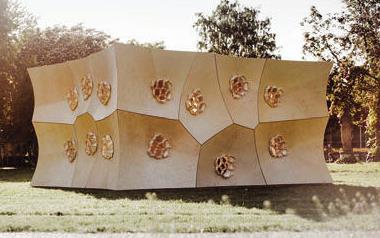

Fig. 1. a, b: The transfer of the biological principle of shape change triggered by hygroscopically induced dimensional change to humidity responsive, veneer-composite elements.
For designers, this means that by using such abstracted instructions - design principles, they can create many diverse solutions in which the function of "movement", or reactions to changes in the external environment will be achieved biomimetically. We assume that each such design will have its unique utility value, expression, material composition, size, and artistic and aesthetic character. It can incorporate the given biomimetic feature only in a small detail or on a large scale based on the creativity of the designer.
Tab. 3 Function card – pinecone (part of the database of biomimetic design principles taken from wood).
FUNCTION CARD – Pinecone
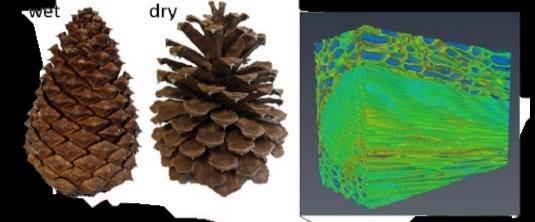
picture credit:(QUAN et.al. 2021) Function hygroscopic | hydraulic motion
Biomimetic function taxonomy
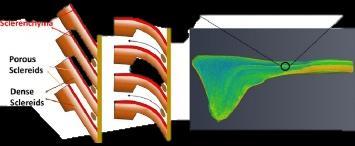
Move
Strategy Arrangement of thick-walled scales on the outside of the cone and thin-walled scales on the inside in a phyllotaxy/Fibonacci sequence Mechanism Since cones are composed of dead cells like wood, these movements are primarily a mechanical (passive) hygroscopic reaction and depend on the chemical composition (ROWELL 2005) and the structural arrangement or functional morphology of the cones (DAWSON et al. 1997; HARLOW et al. 1964). An example is a pinecone consisting of dozens of seed scales of varied sizes and wall thicknesses arranged in Fibonacci sequence (KILMER 1971). The thick-walled scales are on the outside of the cone, while the thin-walled ones are on the inside. “Under moist conditions, when a wind dispersal of seeds is not favourable, the scales curve upwards, the cone closes and the winged, airborne seeds are protected. On the other hand, in dry conditions they bend downwards and release the seeds, which then fly away" (POPPINGA et al. 2017). The mechanism, however, is that moisture or water falls primarily only on the outer scales, which move it towards the inner layers of the cone. Here, with the help of hemicellulose and amorphous cellulose, water is bound in the cell walls (POPPINGA et al. 2017) and a subsequent hygroscopic reaction - swelling occurs. In this process, it pushes the scale upward and the cone closes. If the lower layer dries and shrinks, it pulls the scale down again and the cone opens. (RÜHE and SEIDLER 2022)
Design principle
The design, which we want to be able to open and close with changing humidity without the use of mechanical forces, must be designed to consist of a set of thick-walled scales deposited on the outside of the object and thin-walled scales deposited on the inside of the object. The movements would appear due to the interaction of two tissue layers in the scale of our design: An upper, rigid layer that absorbs no or extraordinarily little water, and a lower layer that swells and elongates due to moisture. The material to use must also be hygroscopic or capable of accepting moisture from the environment.
103
BIOINSPIRED LAMP – Bordered pits of conifers
The concept study of the geometry of natural shapes and their applications in the design 2019/ inspired by microstructure of wood.
The second quite different example is the conceptual design study focused on the emulating and abstraction of the beauty of natural geometry and functions occurring in the wood. The goal of the study was to introduce designers to the topic of geometric principles in nature, their rules, possibilities of construction, and utilization in the work of art and design. Bioinspiration was taken from the microstructure of wood and selected elements related to wood. The design study showed the procedure when theoretical research and familiarization with the biological mechanisms behind function and geometry were followed by practical application of the acquired knowledge in the art design of a specific object - a lighting device using the methods of biomimicry. The created object was inspired by geometric relations based on the micro world of nature, and the metaphorical transformation of shapes and their function in nature into the design concept. The outputs of the design study were the scale models, sketches, geometrical analyses, and minimum viable prototype. The first steps of the creation of the study were aimed at the acquaintance of the theoretical basics of wood anatomy on a micro-level, biomimicry and biomimetic methods, and the basic geometric design principles that occur in the wood on micro and macro level (Lizoňová and Tončíková 2019). Then the selected structures and mechanisms were studied from a natural and geometric point of view and function cards for selected elements and mechanisms were created. Geometric elements and basic natural shapes have become the basis for designing new products.
The presented example of design study was in the frame of biomimicry inspired by bordered pits of conifers. In addition to the functional card (Tab. 1) for understanding the biological mechanism of the bordered pits of conifers, the designers had at their disposal several micro photos in various positions. The presence of the golden ratio, curves, and radial symmetry in sections and images was observed and analysed during the design process. Subsequently drawing studies (Fig. 2c) in which the flow of light metaphorically replaced the flow of liquid through the bordered pits of conifers were created. Figure 2a shows an analysis of geometric relations that were simplified into a drawing study. Figure 2b shows the created working model. The prototype and applications of the designed lamp in interiors are presented in Figure 2d. The goal of this study was not to create a perfect emulation of the biomimetic principles that work in wood in the form of a functional design but to show the way and methodology of how design can be inspired by nature at various levels - literal and metaphorical.
104
2 a
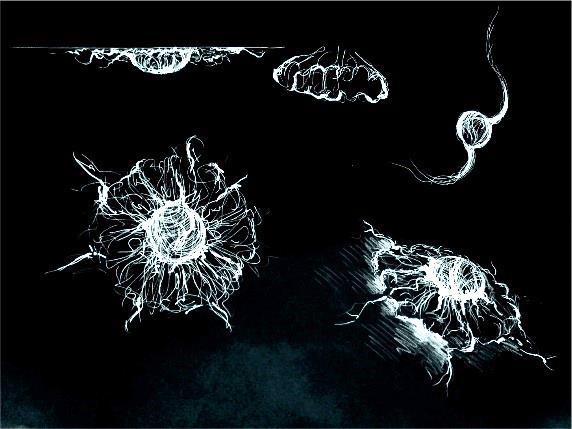
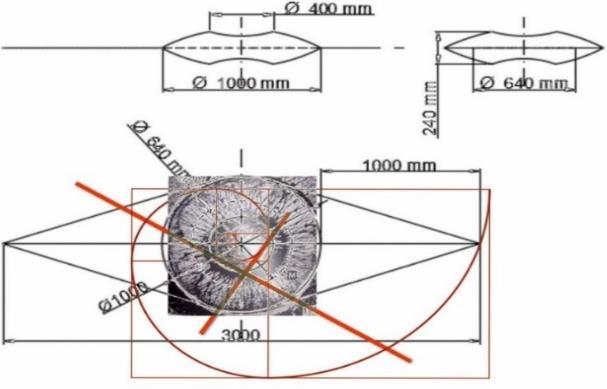
2 c
2 b 2 d
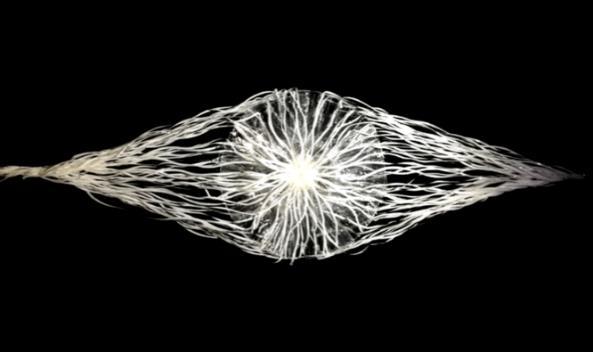
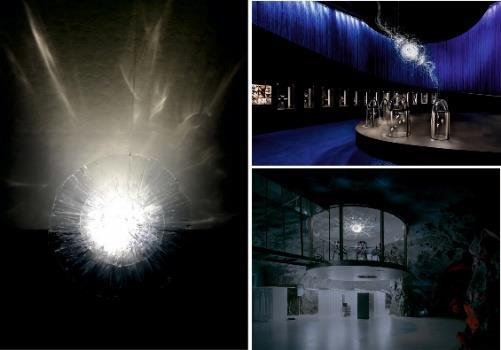
Fig. 2: 2a – geometric analyses and technical drawing of proposed bioinspired concept; 2b - working model of the proposed design concept; 2c - drawings inspired by bordered pits; 2d – lamp prototype and application in interior design. Design: Vrábelová Marianna, Vrábľová Natália
CONCLUSION
Nature-inspired innovations are unique in many aspects. They are ideally suited for their function and elegance, and we often see beauty in these solutions. Biomimetics and biomimicry as methods for applied research in design and art will undoubtedly play a significant role in the bio(r)evolution of design in the following decades. The research is focused on wood as a "living matter" and material. The wood, in its complexity, represents a source of bioinspiration on many levels. This research was launched in the first stage with the set of methodology based on the creation of a database of as many so-called biomimetic function cards as possible to ensure maximization of utilizing many biological mechanisms observed in wood. The aim is to give designers, architects, and innovators instructions on how to mimic functions and shapes in their own designs. The most exciting perspective of bioinspiration is that material microstructure may be considered materially programmed information. In wood, the cellulose architecture encodes a complex set of movements triggered by humidity changes. Wood and most biological materials are active by hosting the information required in a particular architecture of fibre and by directly using environmental gradients as energy sources. The long-term objective of this project is to provide instruction in the form of function cards, and in the following stages, develop models and prototypes of interior elements, materials, or furniture which will achieve the demanded function and visual and aesthetical properties based on the transfer of biomimetic properties of wood. The application of natural materials within furniture design and interior architecture is conventionally connected with a healthy micro-environment and the application of natural materials with unique properties. The intention of the proposed project is not to replace natural materials in an interior dominated by wood with their synthetic variants. The vision is just to emulate these properties with the objective to develop and simulate their unique parameters artificially and to scale them in a new sustainable form for the 21st century that enables the development of a new generation of nature-inspired products. Nature will not be
105
used as a primary source of material but as a model, mentor, and measure for the applied research.
REFERENCES
ALAM, P. 2015. Biomimetic composite materials inspired by wood. In Wood Composites, 357–394. DOI: 1016/B978-1-78242-454-3.00014-7 BASKIN, J.M., BASKIN, C.C., DIXON, K.W. 2006. Physical dormancy in the endemic Australian genus Stylobasium, a first report for the family Surianaceae (Fabales). In Seed Science Research 16(3), 229–232. DOI: 10.1079/SSR2006248229 BAUMEISTER, D., TOCKE, R., DWYER, J., RITTER, S., BENYUS, J. 2013. Biomimicry Resource Handbook: a seed bank of knowledge and best practices. In Missoula: Biomimicry, 3. 8. BENYUS, J.M. 2021. Biomimicry: innovation inspired by nature., New York: William Morrow. BURGERT, I., FRATZL, P. 2009. Actuation systems in plants as prototypes for bioinspired devices. Philosophical Transactions of the Royal Society A: Mathematical, Physical and Engineering Sciences, 367(1893), pp.1541-1557. DOI: 10.1098/rsta.2009.0003
CORREA, D., PAPADOPOULOU, A., GUBERAN, C., JHAVERI, N., REICHERT, S., MENGES, A., TIBBITS, S. 2015. 3D-printed wood: programming hygroscopic material transformations. In 3D Printing and Additive Manufacturing, 2(3), pp.106-116. DOI: 10.1089/3dp.2015.0022 CORREA, D., POPPINGA, S., MYLO, M.D., WESTERMEIER, A.S., BRUCHMANN, B., MENGES, A., SPECK, T. 2020. 4D pine scale: biomimetic 4D printed autonomous scale and flap structures capable of multi-phase movement. In Philosophical Transactions of the Royal Society A, 378(2167), p.20190445. DOI: 10.1098/rsta.2019.0445 CORREA, D., David KRIEG, O., MENGES, A., REICHERT, S., RINDERSPACHER, K. 2013. HygroSkin: A prototype project for the development of a constructional and climate responsive architectural system based on the elastic and hygroscopic properties of wood. DAWSON, C., VINCENT, J.F., ROCCA, A.M. 1997. How pine cones open. In Nature, 390(6661), pp.668-668. DOI: 10.1038/37745 DUTE, R.R. 2015. Development, structure, and function of torus–margo pits in conifers, ginkgo and dicots. In Functional and ecological xylem anatomy (pp. 77-102). In Springer, Cham. DOI: 10.1007/978-3-319-15783-2_3 EDER, M., SCHÄFFNER, W., BURGERT, I., FRATZL, P., 2021. Wood and the activity of dead tissue.In Advanced Materials, 33(28), p. 2001412.DOI: 10.1002/adma.202001412 ELBAUM, R., ZALTZMAN, L., BURGERT, I., FRATZL, P., 2007. The role of wheat awns in the seed dispersal unit. Science, 316(5826), pp.884-886. DOI: 10.1126/science.1140097 FRATZL, P., WEINKAMER, R. 2007. Nature’s hierarchical materials. In Progress in materials Science, 52(8), pp.1263-1334. DOI: 10.1016/j.pmatsci.2007.06.001 GOSS, J. 2010, Biomimicry – Looking to nature for design solutions, UMI dissertation publishing 2010, UMI 1476728. GULMANELLI, S. 2008. “Biomimicry.” Special Issue, Domus (February 2008): p. 32-37 HARLOW, W.M., CÔTÉ, W.A., DAY, A.C. 1964. The opening mechanism of pine cone scales. In Journal of Forestry, 62(8), pp.538-540. DOI: 10.1093/jof/62.8.538 HELMS, M., VATTAM, S.S., GOEL, A.K. 2009. Biologically inspired design: process and products. In Design studies, 30(5), pp. 606-622. DOI: 10.1016/j.destud.2009.04.003 KILMER, W.L. 1971. On growing pine cones and other Fibonacci fruits—McCulloch's localized algorithm. In Mathematical Biosciences, 11(1-2), pp.53-57. DOI: 10.1016/0025-5564(71)90007-1 LIZOŇOVÁ, D., TONČÍKOVÁ, Z. 2019. Exploring the application of nature-inspired geometric principles when designing furniture and interior equipment. In Acta Facultatis Xylologiae Zvolen res Publica Slovaca, 61(1), pp.131-145. DOI: 10.17423/afx.2019.61.1.13 MADSEN, B. 1992. Structural behaviour of timber. Timber Engineering LTDNorth Vancouver. 405 p. MARKSTEDT, K., HÅKANSSON, K., TORIZ, G., GATENHOLM, P., 2019. Materials from trees assembled by 3D printing–Wood tissue beyond nature limits. In Applied Materials Today, 15, pp.280-285. DOI: 10.1016/j.apmt.2019.02.005
106
MENGES, A., REICHERT, S. 2015. Performative wood: physically programming the responsive architecture of the HygroScope and HygroSkin projects. In Architectural Design, 85(5), pp.66-73. DOI: 10.1002/ad.1956 POPPINGA, S., NESTLE, N., ŠANDOR, A., REIBLE, B., MASSELTER, T., BRUCHMANN, B., SPECK, T. 2017. Hygroscopic motions of fossil conifer cones. In Scientific reports, 7(1), pp.1-4. DOI: 10.1038/srep40302 POŽGAJ, A., CHOVANEC, D., KURJATKO, S., BABIAK, M. 1997. Štruktúra a vlastnosti dreva. Príroda a. s., Bratislava. 485 p. REYSSAT, E., MAHADEVAN, L. 2009. Hygromorphs: from pine cones to biomimetic bilayers. In Journal of the Royal Society Interface, 6(39), pp.951-957. DOI: 10.1098/rsif.2009.0184 REICHERT, S., MENGES, A. 2010. Responsive surface structures. Bionik pat. aus. der. natur. Bremen: Bionik-Innovations-Centrum (BI-C) Bremen, pp.28-34. ROWELL, R.M. 2005. Handbook of wood chemistry and wood composites. CRC press. ROWLAND, R. 2017. Biomimicry step-by-step. Bioinspired, Biomimetic and Nanobiomaterials, 6(2), pp.102-112. DOI: 10.1680/jbibn.16.00019 RÜHE, J., SEIDLER, S. 2022. New insights into the movement of pine cone scales, [online]31.5.2022, Electronic Resource: Office of University and Science Communications Albert-Ludwigs-Uni ersität Freiburg, [cit.20.06.2022], https://kommunikation.uni-freiburg.de/pm-en/press-releases-2022/newinsights-into-the-movement-of-pine-cone-scales?set_language=en. QUAN, H., PIROSA, A., YANG, W., RITCHIE, R.O., MEYERS, M.A. 2021. Hydration-induced reversible deformation of the pine cone. In Acta Biomaterialia, 128, pp.370-383. DOI: 10.1016/j.actbio.2021.04.049 SCHULTE, P.J., HACKE, U.G. 2021. Solid mechanics of the torus–margo in conifer intertracheid bordered pits. New Phytologist, 229(3), pp.1431-1439. https://doi.org/10.1111/nph.16949 STANZL-TSCHEGG, S.E. 2011. Wood as a bioinspiring material. In Materials Science and Engineering: C, 31(6), pp.1174-1183. DOI: 10.1016/j.msec.2010.12.001 THIBAUT, B. 2019. Three-dimensional printing, muscles, and skeleton: mechanical functions of living wood. In Journal of Experimental Botany, 70(14), pp.3453-3466. DOI: 10.1093/jxb/erz153 TONN, B.E. 2007. Futures sustainability. In Futures, 39(9), pp.1097-1116. DOI: 10.1016/j.futures.2007.03.018 VINCENT, J.F., BOGATYREVA, O.A., BOGATYREV, N.R., BOWYER, A. and PAHL, A.K. 2006. Biomimetics: its practice and theory. In Journal of the Royal Society Interface, 3(9), pp.471-482. DOI: 10.1098/rsif.2006.0127
ACKNOWLEDGEMENT:
This work was supported by the Slovak Research and Development Agency under the Contract no. APVV-21-0015.
AUTHORS’ ADDRESSES:
Assoc. prof. Zuzana Tončíková, ArtD. Technical University in Zvolen Faculty of Wood Sciences and Technology Department of Furniture and Interior Design T. G. Masaryka 24 960 01 Zvolen, Slovakia
Mgr. Art. Katarína Csúzová Technical University in Zvolen Faculty of Wood Sciences and Technology Department of Furniture and Interior Design T. G. Masaryka 24 960 01 Zvolen, Slovakia
107
108







